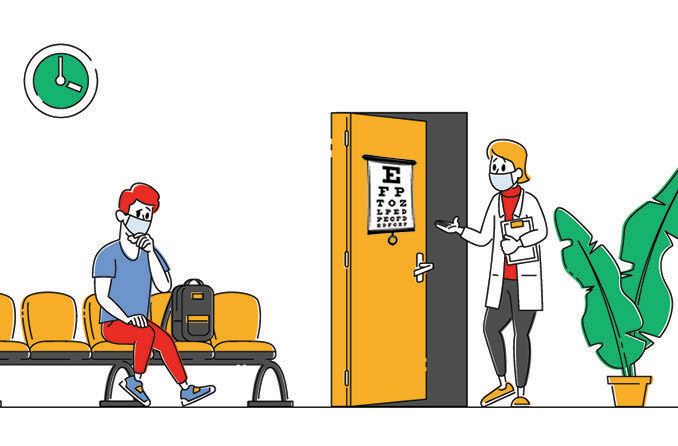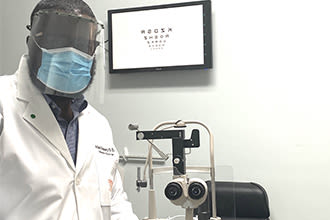Eye doctors add safety measures to cut COVID-19 risk

The coronavirus pandemic has temporarily closed countless American businesses, but some eye doctors' offices often are open — though with reduced hours and with added safety precautions in place.
Optometrists, ophthalmologists and opticians continue to offer essential eye care ranging from saving a patient’s vision to mending a customer’s only pair of glasses.
Urgent optical needs don’t stop during a pandemic, but eye care has changed.
Added safety measures include:
Virtual visits — by phone, FaceTime or a telehealth app — have replaced some in-office care.
Patient visits are staggered, and everything is disinfected in between appointments.
Face masks, gloves and safety shields are the new standard of safe care for patients and staff.
Curbside delivery and ship-to-home are options for customers picking up glasses or ordering contact lenses.
SEE RELATED: Coronavirus: How eyes may play a role in its spread
Essential vs. routine vision
What “essential” services are offered by your eye doctor and vision center now? Essential covers nearly everything except eye exams for a new prescription for glasses or contact lenses.
What prompted the distinction between essential and routine care? The Centers for Disease Control and Prevention (CDC) recommended March 17 that all health care providers suspend routine care. Since then, CDC has recommended that in-person services be carefully expanded based on local conditions and recommendations of state and local officials.
How do eye care practices and vision centers define essential care?
LensCrafters, which lists its COVID-19 safety precautions on its website, says essential care includes “trauma, vision loss, pain, redness or an exam required for eyeglasses due to a lost or broken pair.”
Visionworks, which declares "We Are Open" on its website, lists as essential eye care “illnesses or injuries that require prompt attention and/or when patients experience sudden changes in eye or visual health.”
Pearle Vision’s COVID-19 statement defines essential care as including “trauma, vision loss, pain, redness or an exam required for eyeglasses due to a lost or broken pair. For routine annual exams, please revisit your appointment needs at a later date.”
At Texas State Optical locations, like at many eye care practices across the country, patients get emergency care, contact lens prescriptions filled, and broken glasses are repaired or replaced.
“We're going to do all we can to help you with your eye care,” says Jack Day-Welch, a practice development manager for two Texas State Optical stores in the Dallas-Fort Worth area.
“The whole point of the added safety precautions — and the use of new ways to serve patients and customers — is to show patients, ‘We’re here for you,’” he adds.
“We’re here for you” can have added meanings now.
With schools still closed and children at home, calls from parents desperate to get their child’s glasses fixed come in three or four times a day, Day-Welch says.
COVID-19’s arrival during flu and allergy seasons has brought its own uptick in eye-related problems.
“On the patient-care side, we’re seeing more emergency eye care visits than usual,” Day-Welch says, adding that allergic conjunctivitis and corneal abrasions (scratches on the eye) are on the rise.
Now, emergency care visits at a growing number of practices begin with a phone screen or virtual visit to assess whether in-office care is warranted.
SEE RELATED: Children are missing eye exams due to COVID-19
Virtual visits connect patients
The ability to provide eye care for patients via virtual visits could play a key role in eye care even after the coronavirus pandemic ends.
“The cat is out of the bag when it comes to telehealth,” says Dr. Adam Ramsey, who operates Socialite Vision in West Palm Beach, Florida. “It would be harder to try to go backward, than to move forward and find ways for telemedicine to be a win for both the patient and the provider.”

Dr. Adam Ramsey of Socialite Vision has a shield to protect patient and eye doctor during slit lamp eye exams.
Socialite Vision began implementing telehealth practices before the COVID-19 outbreak began, and it has ramped up its use to limit the spread of the novel coronavirus.
Ramsey sees a particular benefit for patients with minor concerns, when the benefit of an in-person visit would be outweighed by the potential health risk.
“I believe telehealth is perfectly situated to enhance the contact lens follow-up experience for patients, as well as mild cases of dry eye and allergies,” Ramsey says.
While Ramsey admits that telehealth can be both a “gift and a curse,” he sees virtual visits as a way forward for eye care, beyond the distanced days of COVID-19.
Dr. Joseph Allen, an optometrist in Buffalo, Minnesota, and host of the YouTube channel Doctor Eye Health, has reservations about telehealth but also understands its benefit during the current crisis.
“I still feel [telehealth] is below the standard of care for ocular disease, and I would prefer to see patients in the office,” Allen says.
“However, with that being said, I do feel it will help people get better access to care,” he adds. “A patient who is having symptoms, but is hesitant to come in for an exam, may feel more comfortable to check in online.
“That is where a trained eye care professional could easily triage the next appropriate management and possible treatment,” Allen says.
READ NEXT: Should I wait to have eye surgery until after COVID-19?
Face masks, gloves, face shields to cut COVID-19 risk
During essential visits, eye doctors and their staff are doing everything they can to maximize the safety of both patients and employees. Each location is taking different measures to protect well-being across the board.
At Socialite Vision, several safeguards have been put in place, including gloves, masks and face shields for staff members to reduce the spread of COVID-19, the respiratory disease caused by coronavirus.
“As health care providers, our first mission is to do no harm,” Ramsey says. “It is imperative that we take proper safety precautions to assist in flattening the coronavirus curve.”
At small practices and national chains like Pearle Vision, patients are asked to reschedule if they have flu-like symptoms, have recently traveled outside the country or have been exposed to someone with COVID-19.
At Visionworks, a patient’s temperature is checked upon arrival with a contactless thermometer, its website says.
Additionally, LensCrafters and Visionworks both limit exams to two every hour, also ensuring no more than one patient is in the waiting area at a time.
After a Pearle Vision eye care appointment (and at other eye care practices), everything is sanitized.
“During the pandemic, we have intensified cleaning procedures that include thorough cleaning of the space following every patient interaction,” says Alex Wilkes, Pearle Vision senior vice president and general manager.
To further limit exposure, their locations have temporarily reduced hours of operation, but continue to reserve the first hour for the elderly and medically vulnerable, Wilkes says. They’re also taking additional measures to prevent viral spread.
“Facial masks and gloves have been made available for associates to voluntarily wear when interacting with patients,” Wilkes says. “Best practice reminders of proper hand-washing and maintaining 6-feet distance, when possible, have also been communicated to our associates.”
Wilkes also notes the addition of over-sized “shields” specifically for slit lamp procedures.
What is a slit lamp? A slit lamp is a table-mounted biomicroscope that shines bright light into the patient’s eye, allowing the doctor a highly magnified view of external and internal structures of the eye. A slit lamp exam is an important part of a comprehensive eye exam and requires a close doctor-to-patient distance.
A shield can stop stray respiratory droplets, the primary method of coronavirus transmission, from being spread.
Shields are now becoming commonplace to help control the COVID-19 pandemic — not only in eye care practices but anywhere that requires face-to-face interaction. You’ve probably already seen these shields in the checkout lane at your grocery store.
SEE RELATED: Patients returning to eye doctors during COVID-19 pandemic
Lasting changes to eye care
As states and cities allow businesses to reopen, the availability of routine eye exams will improve. But safety shields and changes to office protocols to protect the patient, eye doctor and office staff likely will be part of the new norm.
There may even be a rush to book exams to get needed glasses and updated prescriptions.
Big changes are ahead for the eye care industry as practices prepare to safely resume normal business, Ramsey says.
“Most offices will have to adopt new strategies, like limiting the number of patients in the office at one time, more thorough sanitization between patients, and sterilization of the office fixtures and equipment,” Ramsey says.
Safety measures some eye care practices are already taking to ensure social distancing and reduce the spread of the coronavirus may become standard post-pandemic:
Go paperless: Patients likely will be encouraged (or required) to fill out forms and questionnaires at home.
More FaceTime: Virtual visits and FaceTime consultations reduce or eliminate physical face time between patients and an eye care practice’s staff — ensuring the health of everyone.
Wait in your car: Patients may be asked to wait in their cars instead of in the waiting room, and limit the number of adults accompanying them.
Curbside service and ship-to-home: When a child’s glasses are repaired, Texas State Optical’s Day-Welch delivers them (wearing face mask and gloves) to the parents’ car. Ship-to-home options for contacts or glasses save customers’ time and gas and reduce the risk of possible coronavirus infection.
The gravity of the sweeping changes to eye care are not lost on Socialite Vision’s Ramsey.
The only constant in life is change, Ramsey says, recalling the famed phrase of Greek philosopher Heraclitus. The eye care industry, like workers all across the land, must adapt to the changing world.
“Some things that happen in life change the course of history,” Ramsey says, “and I believe in our lifetime, COVID-19 will do just that.”
Page published on Sunday, April 19, 2020




